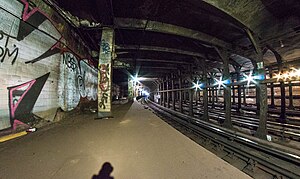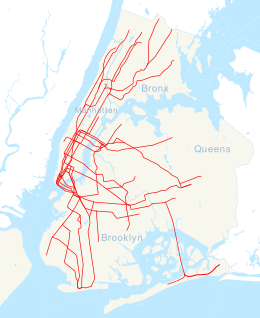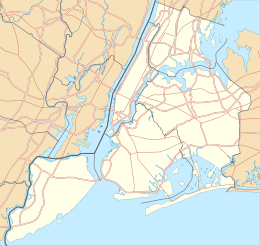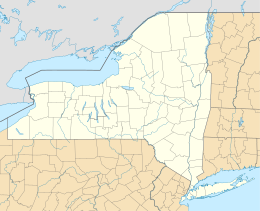railroad.wikisort.org - Station
The Worth Street station was a local station on the IRT Lexington Avenue Line of the New York City Subway. It is located at Lafayette Street and Worth Street, in Civic Center, Manhattan.
Worth Street | ||||||||||||||||||||||||||||||||||||||||||||||||||||||||||||||||||||||||||||||||||
|---|---|---|---|---|---|---|---|---|---|---|---|---|---|---|---|---|---|---|---|---|---|---|---|---|---|---|---|---|---|---|---|---|---|---|---|---|---|---|---|---|---|---|---|---|---|---|---|---|---|---|---|---|---|---|---|---|---|---|---|---|---|---|---|---|---|---|---|---|---|---|---|---|---|---|---|---|---|---|---|---|---|---|
| Former New York City Subway station | ||||||||||||||||||||||||||||||||||||||||||||||||||||||||||||||||||||||||||||||||||
 Platform of the Worth Street station | ||||||||||||||||||||||||||||||||||||||||||||||||||||||||||||||||||||||||||||||||||
| Station statistics | ||||||||||||||||||||||||||||||||||||||||||||||||||||||||||||||||||||||||||||||||||
| Address | Lafayette Street & Worth Street New York, NY | |||||||||||||||||||||||||||||||||||||||||||||||||||||||||||||||||||||||||||||||||
| Borough | Manhattan | |||||||||||||||||||||||||||||||||||||||||||||||||||||||||||||||||||||||||||||||||
| Locale | Civic Center | |||||||||||||||||||||||||||||||||||||||||||||||||||||||||||||||||||||||||||||||||
| Coordinates | 40.7155°N 74.003°W | |||||||||||||||||||||||||||||||||||||||||||||||||||||||||||||||||||||||||||||||||
| Division | A (IRT)[1] | |||||||||||||||||||||||||||||||||||||||||||||||||||||||||||||||||||||||||||||||||
| Line | IRT Lexington Avenue Line | |||||||||||||||||||||||||||||||||||||||||||||||||||||||||||||||||||||||||||||||||
| Services | None (abandoned) | |||||||||||||||||||||||||||||||||||||||||||||||||||||||||||||||||||||||||||||||||
| Structure | Underground | |||||||||||||||||||||||||||||||||||||||||||||||||||||||||||||||||||||||||||||||||
| Platforms | 2 side platforms | |||||||||||||||||||||||||||||||||||||||||||||||||||||||||||||||||||||||||||||||||
| Tracks | 4 | |||||||||||||||||||||||||||||||||||||||||||||||||||||||||||||||||||||||||||||||||
| Other information | ||||||||||||||||||||||||||||||||||||||||||||||||||||||||||||||||||||||||||||||||||
| Opened | October 27, 1904[2] | |||||||||||||||||||||||||||||||||||||||||||||||||||||||||||||||||||||||||||||||||
| Closed | September 1, 1962[3] | |||||||||||||||||||||||||||||||||||||||||||||||||||||||||||||||||||||||||||||||||
| Station succession | ||||||||||||||||||||||||||||||||||||||||||||||||||||||||||||||||||||||||||||||||||
| Next north | Canal Street | |||||||||||||||||||||||||||||||||||||||||||||||||||||||||||||||||||||||||||||||||
| Next south | Brooklyn Bridge–City Hall | |||||||||||||||||||||||||||||||||||||||||||||||||||||||||||||||||||||||||||||||||
| ||||||||||||||||||||||||||||||||||||||||||||||||||||||||||||||||||||||||||||||||||
| ||||||||||||||||||||||||||||||||||||||||||||||||||||||||||||||||||||||||||||||||||
| ||||||||||||||||||||||||||||||||||||||||||||||||||||||||||||||||||||||||||||||||||
The Worth Street station was constructed for the Interborough Rapid Transit Company (IRT) as part of the city's first subway line, which was approved in 1900. Construction of the line segment that includes the Worth Street station started on July 10 of the same year. The station opened on October 27, 1904, as one of the original 28 stations of the New York City Subway. The southbound platform was lengthened in the late 1940s. The station was closed on September 1, 1962, as a result of a platform lengthening project at Brooklyn Bridge–City Hall.
The Worth Street station contains two abandoned side platforms and four tracks. The station was built with tile and mosaic decorations. Many of these decorations have been covered with graffiti.
History
Construction and opening

Planning for a subway line in New York City dates to 1864.[4]: 21 However, development of what would become the city's first subway line did not start until 1894, when the New York State Legislature authorized the Rapid Transit Act.[4]: 139–140 The subway plans were drawn up by a team of engineers led by William Barclay Parsons, chief engineer of the Rapid Transit Commission. It called for a subway line from New York City Hall in lower Manhattan to the Upper West Side, where two branches would lead north into the Bronx.[5]: 3 A plan was formally adopted in 1897,[4]: 148 and all legal conflicts concerning the route alignment were resolved near the end of 1899.[4]: 161 The Rapid Transit Construction Company, organized by John B. McDonald and funded by August Belmont Jr., signed the initial Contract 1 with the Rapid Transit Commission in February 1900,[6] in which it would construct the subway and maintain a 50-year operating lease from the opening of the line.[4]: 165 In 1901, the firm of Heins & LaFarge was hired to design the underground stations.[5]: 4 Belmont incorporated the Interborough Rapid Transit Company (IRT) in April 1902 to operate the subway.[4]: 182
The Worth Street station was constructed as part of the route segment from Chambers Street to Great Jones Street. Construction on this section of the line began on July 10, 1900, and was awarded to Degnon-McLean Contracting Company.[6] By late 1903, the subway was nearly complete, but the IRT Powerhouse and the system's electrical substations were still under construction, delaying the system's opening.[4]: 186 [7] The Worth Street station opened on October 27, 1904, as one of the original 28 stations of the New York City Subway from City Hall to 145th Street on the Broadway–Seventh Avenue Line.[2][4]: 186
The first collision in the history of the New York City Subway system occurred at the station on January 11, 1905. On that date, the motorman of a southbound Lenox Avenue train did not obey a caution signal at the Spring Street station, which indicated that there was a train ahead between Canal Street and Worth Street, and collided into a Broadway train that was stopped at Worth Street, waiting for a signal to clear.[8] The accident shattered the glass in the rear car of the Broadway train, and the first two cars of the Lenox Avenue train. Six people were hurt by falling glass.[9] The accident could have been averted if the local tracks had automatic tripping devices, which were present on the express tracks.[10] The installation of these devices on the local tracks was considered to be impractical due to the high frequency of local service.[8] The accident only resulted in a ten minute delay in service, and after it was determined no people were killed, the trains proceeded in regular service.[11]
Service changes and station renovations
After the first subway line was completed in 1908,[12] the station was served by local trains along both the West Side (now the Broadway–Seventh Avenue Line to Van Cortlandt Park–242nd Street) and East Side (now the Lenox Avenue Line). West Side local trains had their southern terminus at City Hall during rush hours and South Ferry at other times, and had their northern terminus at 242nd Street. East Side local trains ran from City Hall to Lenox Avenue (145th Street).[13] In 1918, the Lexington Avenue Line opened north of Grand Central–42nd Street, thereby dividing the original line into an "H"-shaped system. All local trains were sent via the Lexington Avenue Line, running along the Pelham Line in the Bronx.[14]
On March 20, 1906, the IRT tested a vacuum cleaner connected to a portable wagon plant to clean the station. It found that it was very successful at removing dust from the station's tiling and woodwork, and at removing greasy dirt from girders.[15][16]
To address overcrowding, in 1909, the New York Public Service Commission proposed lengthening platforms at stations along the original IRT subway.[17]: 168 As part of a modification to the IRT's construction contracts, made on January 18, 1910, the company was to lengthen station platforms to accommodate ten-car express and six-car local trains. In addition to $1.5 million (equivalent to $43.6 million in 2021) spent on platform lengthening, $500,000 (equivalent to $14,541,000 in 2021) was spent on building additional entrances and exits. It was anticipated that these improvements would increase capacity by 25 percent.[18]: 15 The northbound platform of the Worth Street station was extended about 10 feet (3.0 m) northward into the "electric manhole", a passageway leading to the equipment closet. The southbound platform was extended 15 feet (4.6 m) into the "manholes" in either direction.[18]: 107 Six-car local trains began operating in October 1910.[17]: 168
The city government took over the IRT's operations on June 12, 1940.[19][20] The downtown platform was lengthened in 1948 by the New York City Board of Transportation, providing for the full length of a ten-car, 514-foot-long (157 m) train.[21] The work was done only on the downtown side to save costs, and that platform was chosen for lengthening since it was the main unloading side in the business district.[citation needed]
Closure

On January 3, 1957, the New York City Transit Authority announced that this station would be closed within two years as part of a plan to improve the Brooklyn Bridge–City Hall station. As part of the project, the platforms at Brooklyn Bridge would be lengthened to accommodate ten-car trains, and the curved platform at Brooklyn Bridge would be eliminated. In order to achieve both of these goals, the platforms would be extended 250 feet (76 m) to the north. The Worth Street station would be closed as it would only be 600 feet (180 m) feet away from the platforms at Brooklyn Bridge. If the station were retained, service on the line would be slowed down, and there was no suitable signal system that could operate with such a short distance. The project would cost $4.4 million and was projected to take two years.[22]
The station was closed on September 1, 1962 with the completion of work at Brooklyn Bridge. While the opening of new entrance at the northwest corner of Reade Street and Lafayette Street on that date,[3] it ended up opening a week later.[23] After the Worth Street station's closure, Brooklyn Bridge–City Hall was renamed Brooklyn Bridge–Worth Street.[24] The name change was reverted in 1995.[citation needed]
Station layout
| G | Street level | |
| P Platform level |
Side platform, not in service | |
| Northbound local | ← | |
| Northbound express | ← | |
| Southbound express | | |
| Southbound local | | |
| Side platform, not in service | ||
Like other local stations, Worth Street has four tracks and two abandoned side platforms. The two local tracks, which formerly served the station, are used by the 6 train at all times, <6> trains during weekdays in the peak direction, and the 4 train during late nights. The two express tracks are used by the 4 and 5 trains during daytime hours.[25] The platforms were originally 200 feet (61 m) long, as at other local stations on the original IRT.[5]: 4 [26]: 8 The southbound platform later became 520 feet (160 m) long.[21] The platforms were curved significantly.[25] The curves made it impossible for all doors on trains to open at the station, when it was in use,[27] and many accidents occurred at the large gaps between trains and the platforms.[28] Wide fare control areas were located at the southern end of the platforms.[29]
As with other stations built as part of the original IRT, the station was constructed using a cut-and-cover method.[30]: 237 The tunnel is covered by a "U"-shaped trough that contains utility pipes and wires. The bottom of this trough contains a foundation of concrete no less than 4 inches (100 mm) thick.[26]: 9 Each former platform consists of 3-inch-thick (7.6 cm) concrete slabs, beneath which are drainage basins. The former platforms contain glazed tile columns spaced every 15 feet (4.6 m).[5]: 4 [26]: 9 Alternating platform columns had tiles reading "WORTH".[31] Additional columns between the tracks, spaced every 5 feet (1.5 m), support the jack-arched concrete station roofs.[5]: 4 [26]: 9 Alternating columns between the local and express tracks had black on white signs reading "Worth."[32] There is a 1-inch (25 mm) gap between the trough wall and the platform walls, which are made of 4-inch (100 mm)-thick brick covered over by a tiled finish.[26]: 9
The decorative scheme consisted of blue/green tile tablets, buff tile bands, a green terracotta cornice, and buff terracotta plaques.[26]: 34 [33] The mosaic tiles at all original IRT stations were manufactured by the American Encaustic Tile Company, which subcontracted the installations at each station.[26]: 31 The decorative work was performed by tile contractor Manhattan Glass Tile Company and terracotta contractor Atlantic Terra Cotta Company.[26]: 34 The station walls had shields with the white letter "W".[34] The station's walls and columns have been heavily covered with graffiti.[35]
The station lies beneath the sidewalk on the west side of Foley Square. When the Federal Plaza Building was in the planning stages, it was found that, because of the existence of the station, the building could not extend out to Foley Square. As a result, that structure is set far back from the street, well beyond the station. The building's plaza and fountain lie directly above the station.[citation needed]
See also
- 18th Street (IRT Lexington Avenue Line)
- 91st Street (IRT Broadway – Seventh Avenue Line)
References
- "Glossary". Second Avenue Subway Supplemental Draft Environmental Impact Statement (SDEIS) (PDF). Vol. 1. Metropolitan Transportation Authority. March 4, 2003. pp. 1–2. Archived from the original (PDF) on February 26, 2021. Retrieved January 1, 2021.
- "Our Subway Open: 150,000 Try It; Mayor McClellan Runs the First Official Train". The New York Times. October 28, 1904. p. 1. ISSN 0362-4331. Retrieved April 21, 2020.
- Grutzner, Charles (September 1, 1962). "New Platform for IRT Locals At Brooklyn Bridge to End Jams". The New York Times. p. 42. ISSN 0362-4331. Retrieved May 30, 2010.
- Walker, James Blaine (1918). Fifty Years of Rapid Transit — 1864 to 1917. New York, N.Y.: Law Printing. Retrieved November 6, 2016.
- "Interborough Rapid Transit System, Underground Interior" (PDF). New York City Landmarks Preservation Commission. October 23, 1979. Retrieved November 19, 2019.
- Report of the Board of Rapid Transit Railroad Commissioners for the City of New York For The Year Ending December 31, 1904 Accompanied By Reports of the Chief Engineer and of the Auditor. Board of Rapid Transit Railroad Commissioners. 1905. pp. 229–236.
- "First of Subway Tests; West Side Experimental Trains to be Run by Jan. 1 Broadway Tunnel Tracks Laid, Except on Three Little Sections, to 104th Street -- Power House Delays". The New York Times. November 14, 1903. ISSN 0362-4331. Retrieved May 10, 2022.
- "Blames Motorman For Crash In The Subway. Superintendent Hedley Declares He Ran Past Signals—Clever Device to Guard Express Trains". New York Evening World. January 11, 1905. Retrieved July 6, 2020.
- "Accident In The Subway". Fort Wayne Daily News. January 11, 1905. Retrieved July 6, 2020.
- "First Collision On The New Subway. Fault of Motorman Who Disregarded Warning Signal". Albuquerque Journal. January 18, 1905. Retrieved July 6, 2020.
- "Brooklynites In Crash. Subway Train, Carrying Party Home from Euchre, in Collision—Three Badly Hurt". Brooklyn Times Union. January 11, 1905. Retrieved July 6, 2020.
- "Our First Subway Completed At Last — Opening of the Van Cortlandt Extension Finishes System Begun in 1900 — The Job Cost $60,000,000 — A Twenty-Mile Ride from Brooklyn to 242d Street for a Nickel Is Possible Now". The New York Times. August 2, 1908. p. 10. Retrieved November 6, 2016.
- Brooklyn Daily Eagle Almanac. Brooklyn Daily Eagle. 1916. p. 119.
- "Open New Subway Lines to Traffic; Called a Triumph — Great H System Put in Operation Marks an Era in Railroad Construction — No Hitch in the Plans — But Public Gropes Blindly to Find the Way in Maze of New Stations — Thousands Go Astray — Leaders in City's Life Hail Accomplishment of Great Task at Meeting at the Astor" (PDF). The New York Times. August 2, 1918. p. 1. Retrieved November 6, 2016.
- "Clean Subway By Vacuum. Plain Is Tried as an Experiment and Is Declared To Have Been Successful". The New York Herald. March 21, 1906. Retrieved July 6, 2020.
- "Vacuum Cleaning Tried In Subway. Interborough Makes Practical Test of System at Worth Street Station". Compressed Air. 11 (3): 4049. May 1906.
- Hood, Clifton (1978). "The Impact of the IRT in New York City" (PDF). Historic American Engineering Record. pp. 146–207 (PDF pp. 147–208). Retrieved December 20, 2020.
 This article incorporates text from this source, which is in the public domain.
This article incorporates text from this source, which is in the public domain.{{cite web}}: CS1 maint: postscript (link) - Report of the Public Service Commission for the First District of the State of New York For The Year Ending December 31, 1910. Public Service Commission. 1911.
- "City Transit Unity Is Now a Reality; Title to I.R.T. Lines Passes to Municipality, Ending 19-Year Campaign". The New York Times. June 13, 1940. ISSN 0362-4331. Archived from the original on January 7, 2022. Retrieved May 14, 2022.
- "Transit Unification Completed As City Takes Over I. R. T. Lines: Systems Come Under Single Control After Efforts Begun in 1921; Mayor Is Jubilant at City Hall Ceremony Recalling 1904 Celebration". New York Herald Tribune. June 13, 1940. p. 25. ProQuest 1248134780.
- Proceedings of the New York City Board of Transportation. New York City Board of Transportation. 1949. p. 1585.
- Levey, Stanley. "IRT Will Abandon Worth St. Station; Decision Based on Planned Extension of the Brooklyn Bridge Stop by 250 Feet". The New York Times. ISSN 0362-4331. Retrieved September 4, 2016.
- ERA Headlights. Electric Railroaders Association. 1962.
- "IRT Worth St. Station To Be Closed Reade-Lafayette Stairway To Open". Flickr. New York City Transit Authority. 1962. Retrieved July 6, 2020.
- Dougherty, Peter (2006) [2002]. Tracks of the New York City Subway 2006 (3rd ed.). Dougherty. OCLC 49777633 – via Google Books.
- Framberger, David J. (1978). "Architectural Designs for New York's First Subway" (PDF). Historic American Engineering Record. pp. 1–46 (PDF pp. 367–412). Retrieved December 20, 2020.
 This article incorporates text from this source, which is in the public domain.
This article incorporates text from this source, which is in the public domain.{{cite web}}: CS1 maint: postscript (link) - "Station To Open: $6-Million Subway Platform In Lower Manhattan". The Hackensack Record. August 29, 1962. Retrieved July 6, 2020.
- Skinner, Burrhus Frederic (1957). Verbal Behavior. Appleton-Century-Crofts. ISBN 9780390812957.
- "Fare Control Area at Worth Street". guerrillaexploring.com. Retrieved July 6, 2020.
- Scott, Charles (1978). "Design and Construction of the IRT: Civil Engineering" (PDF). Historic American Engineering Record. pp. 208–282 (PDF pp. 209–283). Retrieved December 20, 2020.
 This article incorporates text from this source, which is in the public domain.
This article incorporates text from this source, which is in the public domain.{{cite web}}: CS1 maint: postscript (link) - "Image of the southbound platform at Worth Street". nycsubway.org. 1960. Retrieved July 6, 2020.
- "Worth Street sign on column". Abandoned Stations. Retrieved July 6, 2020.
- "The Subway and its Stations". Harper's Weekly. 47 (2406): 176. January 31, 1903.
- "Shield at Worth Street". Abandoned Stations. 2002. Retrieved July 6, 2020.
- Anastasio, Joe (August 17, 2005). "Exploring the Abandoned Worth Street Subway Station (2005)". ltvsquad.com. Retrieved July 6, 2020.
External links
| Wikimedia Commons has media related to Worth Street (IRT Lexington Avenue Line). |
- nycsubway.org – IRT East Side Line: Worth Street
- Abandoned Stations — Worth Street
- Forgotten NY — Original 28 - NYC's First 28 Subway Stations
На других языках
- [en] Worth Street station
[ru] Уэрт-стрит (линия Лексингтон-авеню, Ай-ар-ти)
Уэрт-стрит (англ. Worth Street) — бывшая станция Нью-Йоркского метро, расположенная на линии Лексингтон-авеню. Она представлена двумя боковыми платформами, обслуживающими два пути. С 1 сентября 1962 года станция закрыта.Другой контент может иметь иную лицензию. Перед использованием материалов сайта WikiSort.org внимательно изучите правила лицензирования конкретных элементов наполнения сайта.
WikiSort.org - проект по пересортировке и дополнению контента Википедии




